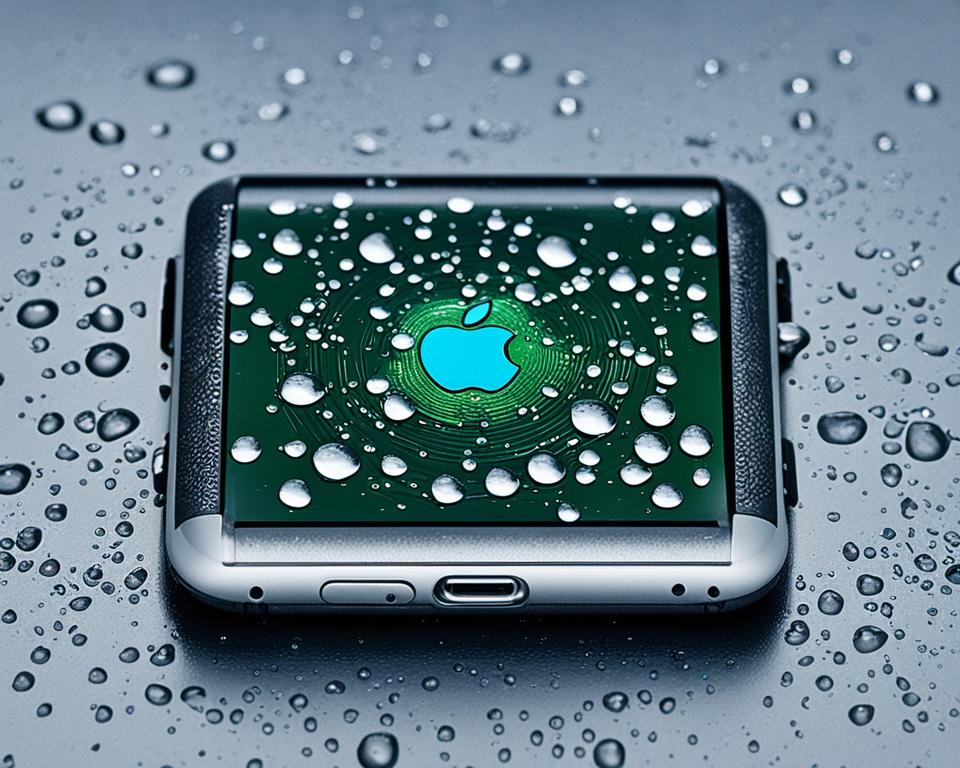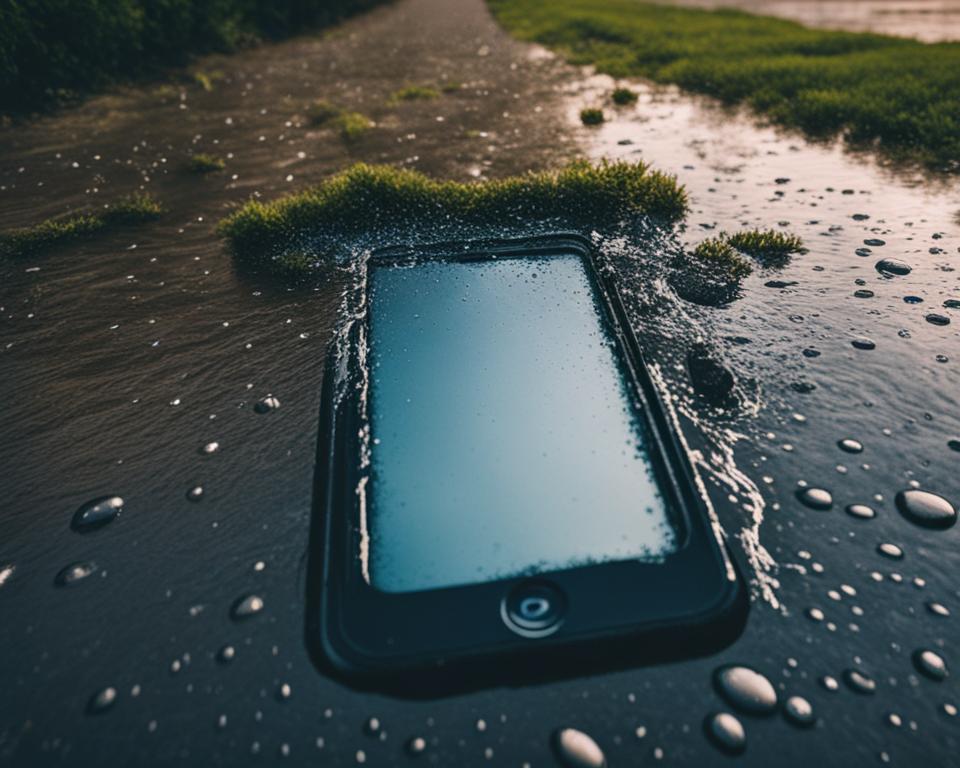
If you have an iPhone, Mac, or iPad, check them for water damage often. Liquid can cause big troubles with your devices. We’ll talk about Liquid Contact Indicators (LCIs), where to find them, how to handle water damage, and if you can get your data back.
Water damage can happen with spills, dunking, or just too much moisture. Sadly, Apple’s warranty does not cover liquid damage.
Apple uses Liquid Contact Indicators (LCIs) in iPhones and iPods. They turn red when they touch water. This shows your device might be water-damaged.
To find the LCI on your Apple product, see Apple’s guide. It tells you where to look on different devices. This makes it easy to spot water exposure.
Seeing a red LCI or thinking your device is wet means you should act fast. Don’t turn it on or plug it in. This could make things worse. Instead, follow steps to dry it out.
It’s suggested to let your device air dry in a warm place for 24-48 hours. Try turning it on after it dries. If it doesn’t work, you may need professional help to get back your data.
Getting data from a wet iPhone is tough, but there’s hope. Experts in Apple data recovery might save your important files. For a full check, talk to these professionals.
To prevent water damage, use water-resistant cases or covers. This is key if you’re often around water. Be careful and try to keep your devices dry.
By taking steps to protect them, you can safeguard your Apple products from water damage. This lets you enjoy them longer without issues.
The importance of Liquid Contact Indicators (LCIs) on Apple devices
Liquid Contact Indicators (LCIs) play a crucial role in checking for water damage on your Apple device. They are visible on most iPhones and iPods. When they touch water or a liquid with water, they turn red.
LCIs help users know if their device has met with liquid. This is key to spotting problems. With this info, users can get help or fix the issue on their own.
LCIs only react to water or liquid contact. They won’t change due to humidity or temperature shifts. This makes sure users get correct info about liquid damage. It stops false alarms.
Apple uses LCIs to improve the user experience and the device’s life. They allow users to know their device’s state and deal with any water damage.
Benefits of Liquid Contact Indicators (LCIs)
- Quick and visible detection of water damage
- Prompt action and prevention of further damage
- Protection of valuable data and device functionality
- Reliable indicator for warranty and service coverage
Comparison between devices with and without LCIs
| Devices with LCIs | Devices without LCIs |
|---|---|
| Immediate visibility of liquid damage | Reliance on other diagnostic methods |
| Prompt identification of water-damaged devices | Uncertainty and potential delays in diagnosis |
| Clear indication for warranty coverage | Additional assessment required |
How to locate the Liquid Contact Indicator (LCI) on your Apple device
Every Apple device comes with a Liquid Contact Indicator (LCI). This tool shows if your gadget has gotten wet. You can see the LCI from the outside. It helps check your Apple device’s health.
To spot the LCI on your Apple gadget, look at the table below. It lists Apple products and where their LCI is. Knowing your device’s LCI spot lets you quickly see if there’s been any water contact.
| Apple Product | Liquid Contact Indicator (LCI) Location |
|---|---|
| iPhone 12 Pro Max | Inside the SIM card slot |
| iPad Air (4th generation) | Inside the SIM card slot |
| MacBook Pro (16-inch) | Next to the headphone jack |
| iPod touch (7th generation) | Inside the headphone jack |
If you think your device got wet and see a red LCI, get help. Contact Apple or an Apple Authorized Service Provider. They will check your device and help solve any water damage issues.

The Liquid Contact Indicator is key for checking on water damage. Knowing where the LCI is and checking it helps you care for your device better. This way, you keep it working well.
What to do if your Apple device is water-damaged
If your Apple device gets water-damaged, act quickly. Quick action can limit damage and might save your device. Here are steps to follow:
- Do not attempt to turn on the device or charge it. Turning on a water-damaged device could cause short circuits. This can further harm the internal parts.
- Remove any external accessories or cases. Taking these off improves airflow. This boosts drying effectiveness.
- Wipe off any visible water on the device’s exterior. Use a soft cloth or tissue gently. This removes moisture from the surface.
- Place the device in a dry and warm environment. Don’t put it in direct sunlight or near heat. Extreme heat can hurt the device. Find a spot that’s well-aired and moderately warm instead.
- Allow the device to air dry for at least 24-48 hours. This gives the device time to dry internally. Being patient is important during this step.
- After the drying process, attempt to turn on the device. If it starts and works fine, it’s likely okay. But if it doesn’t start or acts weird, get professional help.
If your Apple device won’t turn on or keeps having problems, it’s best to contact Apple or an authorized service provider. They can check the damage and try to fix it. These pros know how to handle water-damaged devices.

Can you recover data from a water-damaged iPhone?
Trying to get data back from a water-hit iPhone is tough, particularly if it won’t turn on. Water can greatly harm the iPhone’s inner parts. This might mean you lose your data. Yet, there’s still a chance to get your data back with professional help.
Seek a technician’s help if your iPhone won’t power on after getting wet. They use special tools and know-how to possibly save things like your photos and contacts.
The process to save data from a water-damaged iPhone involves opening it up and checking the parts inside. Then, they try to recover the data with special software. Keep in mind, though, not all recovery efforts work. The outcome heavily depends on how bad the water damage is.
If your iPhone gets water damaged, turn it off right away. This helps avoid more damage. Stay away from DIY fixes, like taking it apart or using a hairdryer. They might just make things worse.
Instead, reach out to a trusted data recovery service or an Apple store. They’ll look at the damage and tell you what can be done. Their advice will give you the best shot at getting your data back.
Getting data from a water-damaged iPhone is hard but not always a lost cause. Getting professional advice and acting quickly improve your chances of saving your important data.
Protecting your Apple devices from water damage
Keeping your Apple devices safe from water is crucial. Using water-resistant cases or covers helps a lot. They add protection, especially near water.
Buy a quality water-resistant case for peace of mind. It keeps your device safe from liquid mishaps.
Try not to expose your devices to water. Keep them away from pools and sinks. By doing this, you lower the chance of water damage.
For more safety, consider AppleCare+ or water damage insurance. These options help if accidents happen. With AppleCare+ or insurance, you’re covered against water damage.

